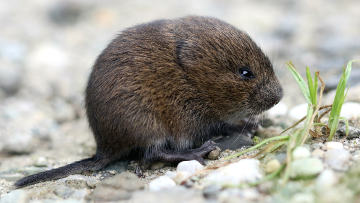

PHOTO COURTESY OF GARRY KESSLER
A vole.
December 1, 2017, Page A8
NATURE NOTES
By Annie Reid
Westborough Community Land Trust
A common but seldom seen creature
Who is this brown, furry, little critter? Not a mouse, not a shrew, but its name rhymes with “mole” – it’s a vole.
We don’t often encounter voles. They live largely unseen by us, in underground tunnels, and they travel through grassy fields and under dead leaves in tunnel-like runways only an inch and half wide. They’re most active at dawn and dusk, like many animals, but they can forage above ground day or night.
These little 5-7-inch creatures of meadows and woodland edges are important in the food chain. Voles are most numerous at this time of year, in late fall, thanks to their prolific spring and summer breeding season. They’re prey for hawks, owls, foxes, coyotes, raccoons, weasels, opossums, snakes, and sometimes even shrews. Your pet cat might show up with a vole. Vole populations tend to peak every 2-5 years.
If you find a vole, dead or alive, how can you tell it’s a vole, rather than a shrew, mole, or mouse? As our photo shows, voles are quite round-looking. They have a blunt nose, round ears, a rounded body, and a short tail.
Unlike voles, shrews have pointed snouts, and so do moles. Moles live almost entirely underground in the dark, so they have tiny eyes. And you can’t really see their ears. Moles also have large feet for digging, especially in front. Mice look somewhat similar to voles, but mice have long tails, in contrast to voles’ short tails.
Massachusetts has at least three kinds of vole – meadow voles (Microtus pennsylvanicus), pine or woodland voles (Microtus pinetorum), and redbacked voles (Myodes gappen). They’re related to mice, lemmings, and muskrats.
How do voles travel around in the winter, especially when snow blankets the landscape? The trick is that they make their runways under the snow. Heat from the earth melts snow that’s close to the ground, creating a small space just under the snow. Protected from frigid air by the snow above, the air in this space remains about 32 degrees F, even when it’s below zero outside for us. This space is a special environment, and voles, mice, and perhaps even some insects make good use of it in winter.
Voles are largely vegetarian, eating mostly grasses, stems, roots, bulbs, seeds, nuts, fruit, fungi, and bark. They’ll also eat insects and dead animals. Their nibbling sometimes damages fruit trees. Wire cages can protect tree trunks and saplings from voles as well as rabbits. Use wire cylinders of ¼-inch mesh, about 18-24 inches high, set 4-6 inches deep into the ground.
Mice have long been used in scientific research, but in recent years voles have become important as well. In studies of social behaviors such as pair-bonding and empathy, researchers have compared different species of voles. For example, they have compared the Midwest’s prairie voles (Microtus ochrogaster), which tend to mate with one partner for life, with our meadow voles, which mate with many partners. By using molecular research techniques and gene sequencing, researchers have related these differing behaviors to different levels of certain hormones (vasopressin, oxytocin), and to different numbers of receptors for these hormones in voles‘ brains. Researchers have also done experiments in which they altered or influenced these social behaviors in voles by giving hormones, blocking receptors, or adding genes.
As winter approaches, think of the voles and other creatures that find ways of surviving it, and keep in mind that these animals might be important to us, or to other life, in unforeseen ways.
Date index
Month (December)
Common name index
Scientific name index
Category index